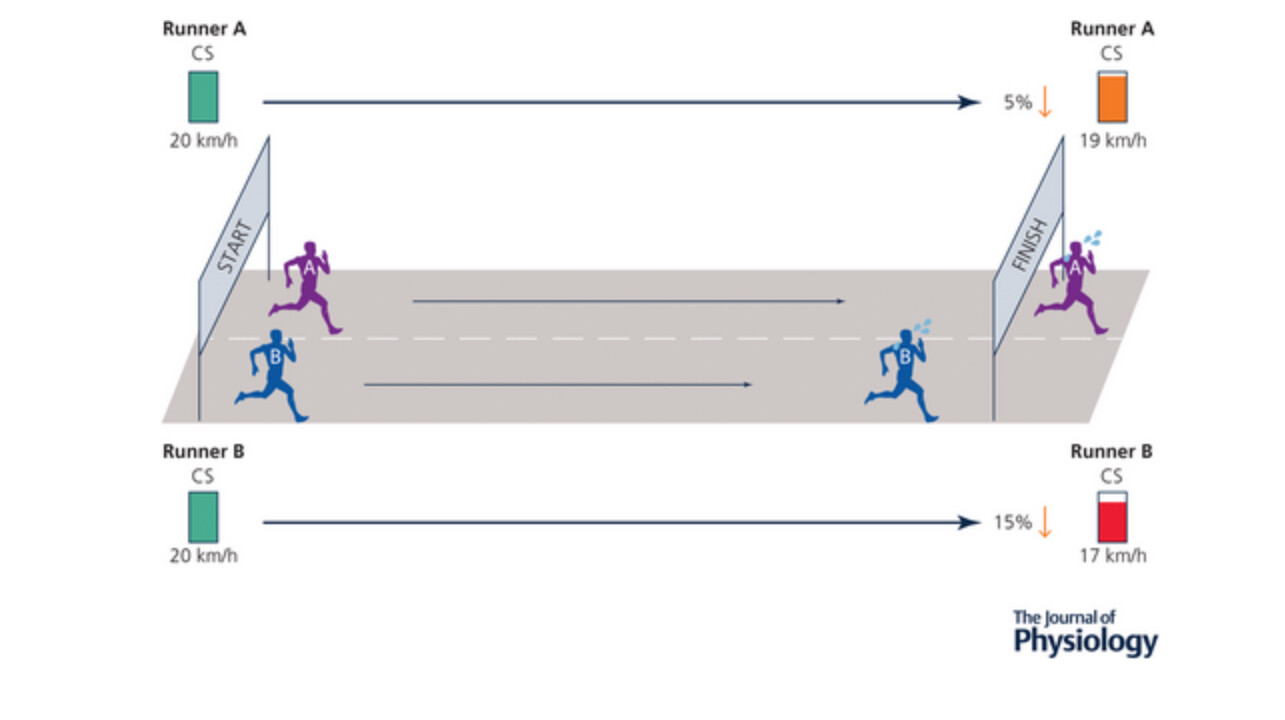Running News Daily
Running News Daily is edited by Bob Anderson in Mountain View, California USA and team in Thika Kenya, La Piedad Mexico, Bend Oregon, Chandler Arizona and Monforte da Beira Portugal. Send your news items to bob@mybestruns.com Advertising opportunities available. Over one million readers and growing. Train the Kenyan Way at KATA Kenya. (Kenyan Athletics Training Academy) in Thika Kenya. KATA Portugal at Anderson Manor Hotel in central portugal. Learn more about Bob Anderson, MBR publisher and KATA director/owner, take a look at A Long Run the movie covering Bob's 50 race challenge.
Index to Daily Posts · Sign Up For Updates · Run The World Feed
How to Access the Elusive “Fourth Dimension” of Endurance
Consider two runners who, in lab testing, have identical values for VO2 max, running economy, and lactate threshold. These are the three quantities in the “standard model” of endurance performance; you can plug them into an equation to calculate your expected marathon time. So who will win the race?
The question is not as hypothetical as it seems. At the top end of the sport, athletes tend to have relatively similar values for all three of the parameters. And if they’re weak in one, they’ll compensate in the other two. And yet lab testing isn’t capable of reliably picking winners. The cyclist with the highest ever VO2 max flopped as a pro; the top marathoners that Nike picked for its Breaking2 marathon, including Eliud Kipchoge, didn’t have unusually high lab numbers. There’s clearly something missing from the equation.

Over the past few years, researchers have zeroed in on a suspect for what one paper calls “the fourth dimension” in the endurance equation. It has various names: durability, physiological resilience, fatigue resistance (which is the term I used when I first wrote about it in 2021). It’s a measure of how much your physiological parameters change over the course of a race. Maybe your VO2 max is 70 ml/kg/min at the start of the race, but has dropped to 65 ml/kg/min by the time you’ve run 20 miles. If your doppelgänger starts with the same values but still has a VO2 max of 67 ml/kg/min after 20 miles, he’ll beat you.
No one is entirely sure what determines fatigue resistance, which is why there’s currently a flurry of research into the topic. Two new papers fill in some gaps, suggesting that what you do before the race and what you do during the race can both have an impact.
The first study, published in the Scandinavian Journal of Medicine & Science in Sports by Runar Jakobsen Unhjem of Nord University in Norway, compares trained runners with “active adults.” The runners had been training for an average of about a decade, averaging a little over 40 miles a week with 10K bests of 33 minutes for men and 38 minutes for women. The active adults played recreational sports but did no more than two days a week of endurance training. Both groups completed a pair of VO2 max and running economy tests before and after an hour of running at a moderate pace corresponding to 70 percent of their individual VO2 max.
In both groups, VO2 max and running economy got worse after an hour of running—but the decline was much steeper in the active adults. Running economy is a measure of how much energy it takes to sustain a given pace; that energy cost increased four times more in the active adults than in the runners. VO2 max dropped by 5.0 percent in the active adults, but just 1.2 percent (not a statistically significant change) in the runners.
That means the active adults had to work harder to sustain the same pace, while at the same time their capacity to do that work was declining. Both groups started at 70 percent of their rested VO2 max, nominally working equally hard. But the figure below shows that by the end the active adults (AA) were pushing at well over 75 or their max while the trained runners (TR) were barely working harder at all:
The takeaway here is that fatigue resistance isn’t just something you’re born with, which is good news. It will improve with training–although what specific type of training targets it best remains to be determined.
The second study, published in the European Journal of Sport Science by a multinational research team led by James Spragg of the University of Cape Town in South Africa, looked at what types of in-race efforts cause the biggest changes in baseline values. Spragg was one of the authors of the study I wrote about back in 2021, which looked at fatigue resistance in professional cyclists after spending amounts of energy ranging between 1,000 and 3,000 kilojoules. But there’s a big difference between doing 3,000 kilojoules of work at a steady pace and doing it with surges and hill-climbs and so on.
The new study tested fatigue resistance in 14 professional cyclists after burning 2,000 kilojoules in two different ways. In one test, they stuck to steady low-intensity riding below their critical power. In the other test, they did 5 eight-minute intervals of hard riding above critical power plus enough easy riding to accumulate roughly the same amount of total work. Sure enough, the higher-intensity intervals produced a greater drop in their baseline physiological values, with the biggest effects on sprinting ability. The results suggest that, within a given run or ride, mid-race surges are what will deaden your finishing kick.
Based on the individual results, Spragg and his colleagues classify the cyclists as fatigue-resistant, semi-fatiguable, or fatigue-sensitive, with three, four, and seven of the riders, respectively, falling into these categories. Their previous research using real-world data from pro cyclists suggests that, all else being equal, fatigue-resistant riders are the ones who win races. So what determines who ends up in which category?
Other studies have linked poor fatigue resistance to inadequate fueling, but in this study all the riders took in 90 grams of carbohydrate per hour. There may also be metabolic differences in how different people use their internal stores of carbohydrate versus fat. The new data suggests that keeping your pace steady and avoiding unneeded surges might be advantageous. And as with the comparison between trained runners and active adults, training might be part of the answer. Previous data from pro cyclists did find that higher training volume was associated with greater fatigue resistance. In other words, we still haven’t figured out how to access the fourth dimension—but we’re finally getting some clues.
(05/11/2024) Views: 377 ⚡AMP



